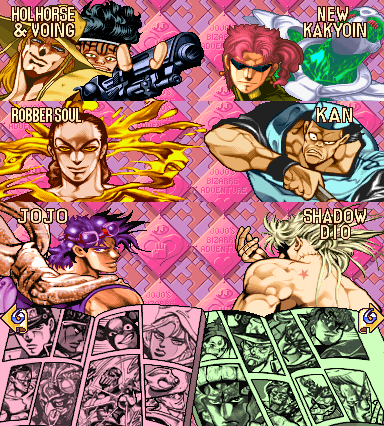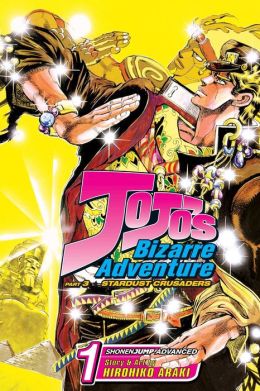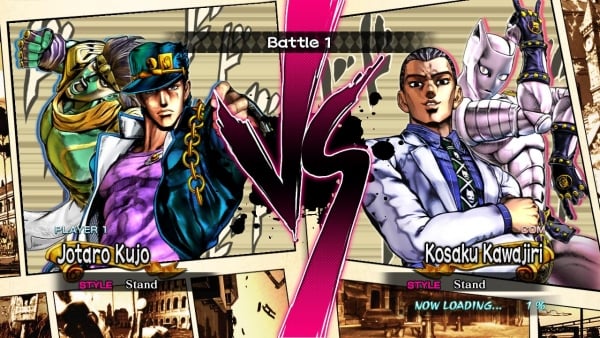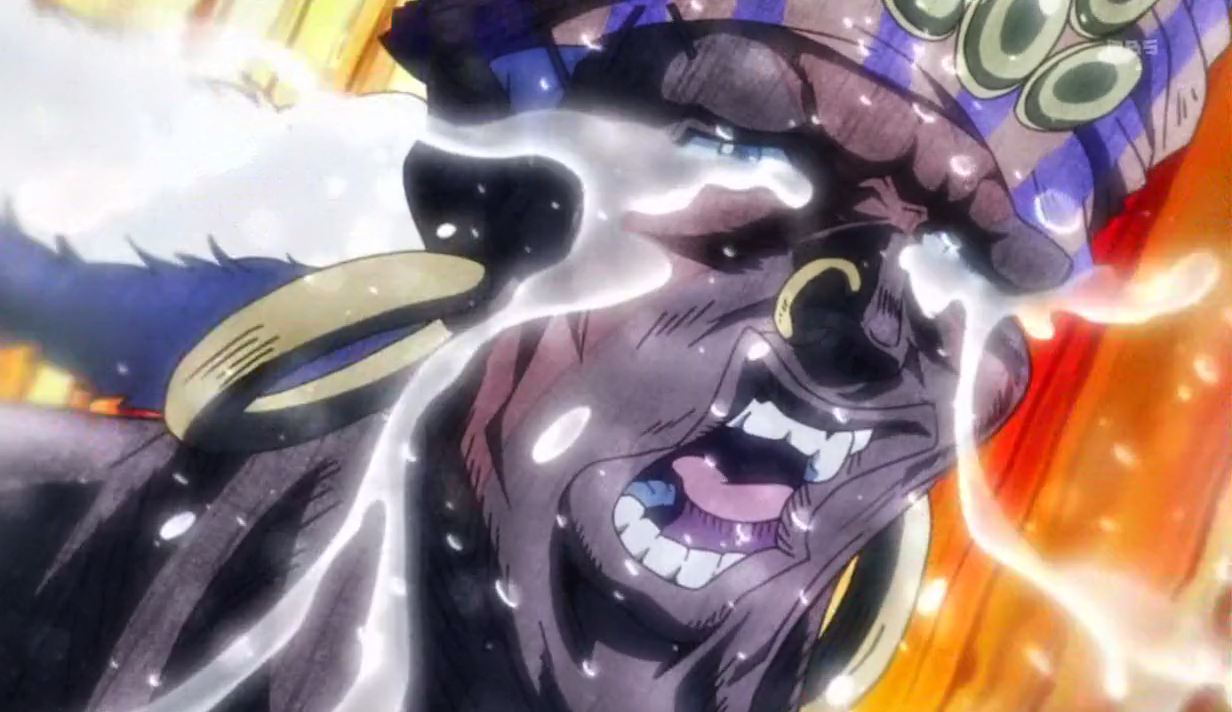The most recent anime adaptation of Hirohiko Araki’s multi-part
manga epic Jojo’s Bizarre Adventure has been making the rounds, quickly gaining
popularity in the anime-loving crowd, particularly once it reached part 3.
For all the years the series has been around, through all of
its 8 parts and generations of different heroes and villains, part 3 is
considered the major turning point and the most famous. It’s so influential, the hero and villain of
part 3 are the only playable characters from the series in Jump Ultimate Stars,
while the heroes from the other parts are only support characters. It’s a story almost as iconic as other Shonen Jump classics like Fist of the North Star and One Piece.
Sadly, although it got a cult following in the internet
community, the Jojo’s Bizarre Adventure manga’s popularity was never anywhere
close to the amazing numbers it got in Japan . Part 3 wasn’t officially translated by Viz
until years after its Japanese release, when it garnered popularity, and every
other part wasn’t translated at all until recently. The garnered popularity that supposedly led
to the manga’s official translation can be attributed to two adaptations that
were released in English beforehand: A set of OVAs and the fighting game by
Capcom.
The Jojo’s Bizarre Adventure Capcom fighting game has heroes
and villains from part 3 (that can fight) as playable characters, and adapts
the story into a series of one-on-one battles, like most shonen-based games. That story in this case, as you might expect,
is bizarre..
For those who aren’t caught up, the Jojo’s Bizarre Adventure
franchise’s parts are similar to the way the King of Fighters storylines work
in that knowledge of previous parts is good to have, but not strictly necessary. However, the first two parts can be easily
summarized:
Part 1 tells the story of an English nobleman named Jonathan
Joestar and his conniving adopted brother Dio.
Dio turned himself into a vampire using an ancient metamorphosing stone
mask that made him more powerful, but also vulnerable to the sun’s energy. To fight him, Jonathan learned Hamon, an
ancient fighting style built around manipulating the sun’s energy, which
allowed Jonathan to damage him.
In the end, Jonathan reduced Dio to a head, but the head
(with some assistance from one of his vampire underlings) later ambushed
Jonathan on a cruise liner with the intent of attaching itself to Jonathan’s
body. However, things went awry, and both
of them went down with the ship.
In part 2, Jonathan’s grandson Joseph Joestar, who inherited
the Hamon technique, had to fight a band of ancient superbeings with the same
vulnerability to sunlight as vampires. Called
the Pillar Men, these humanoid abominations got their name from having been
released from hibernation in stone pillars found in underground ruins.
The Pillar Men created the stone masks that turn people into
vampires, but by combining a large chunk of a special stone called the Red
Stone of Aja with the stone mask, they could instead turn the wearers into a
more powerful lifeform and take away their sunlight vulnerability. To make a long story of hellish training and
crazy schemes short, Joseph won.
Part 3 is kicked off when a coffin is pulled out of the
ocean containing Dio’s head attached to Jonathan Joestar’s body and controlling
it. Joseph, now an elderly man, finds
out about Dio’s return and fills his grandson Jotaro in on Dio and the new
power people have called Stands.
Stands are a manifestation of one’s inner fighting spirit
with common rules as to how they work, barring the occasional exception. They can only be seen by other Stand users
and are projected from a user’s body mentally, meaning that a Stand user
can use their stand and not even look like they’re doing anything. The farther a stand goes from a user’s body,
the weaker it gets (this is how one can know a Stand user is nearby).
Stands are where Araki had the freedom to get creative. There are the usual types of combat stands
you would expect, like fire, ice and swordplay, but throughout Jojo’s Bizarre
Adventure’s long run, there have been stands that really put the “bizarre” in
the title.
For example, Joseph’s stand, Hermit Purple, is able to see
visions of anything in the world and convey it to him by channeling it through
some visual means. He can
get a message by having his stand’s tentacles go into a TV and flip through
channels in such a way that single words and word fragments in each one are played in rapid
succession so that they form a full sentence.
Early on he’s also able to take pictures of where Dio is, wherever he is, by
karate chopping a camera with his stand.
That is unless you ask chucklenuts online.
Other stands include the Hanged Man, which can attack people
by going into reflections and attacking them there, Death 13, which attacks through dreams, and Anubis, a sword stand without an owner that possesses
anyone who holds it unsheathed (including their stand, if they have one).
At first, the primary conflict is going after Dio, of
course, since he’s an evil vampire plotting to take over the world and wreak
havoc with his own stand, but the stakes rise when Jotaro’s mom (and Joseph’s
daughter) develops a stand of her own.
Because she’s not as strong as everyone else, the stand saps her
strength, slowly killing her. The only
way to get rid of the stand is to kill Dio because he (or Jonathan’s body) is
somehow the source of it…..
I’m honestly not entirely sure how that works, but the point
is Jotaro, Joseph and some friends they pick up along the way have to travel to
Egypt
where Dio is hiding and kill him. This
leads them on an adventure across the continent, visiting many different
cultures, all while fighting other stand users Dio sends after them and making
badass poses and catchphrases. The heat
is on!
(Especially when they have to go up against The Sun, whose only power is simulating Arizona .)
Forewarning: If at any point of this article the names are
inconsistent with something you’ve read about Jojo elsewhere, there’s a good reason. Think of it this way: there are 2
translations for names in Jojo’s Bizarre Adventure, the actual way and the
“official” way.
Hirohiko Araki likes American music. You’d swear he was the eccentric mentor to
Daisuke Ishiwatari, because Araki names at least half his characters and stands
after musicians, albums and songs. But
unlike Guilty Gear, the naming in Jojo’s Bizarre Adventure is less subtle, so
in the case of official translations, like the game, names are changed to
protect the innocent (the innocents in this case being the ones who have to
deal with trademark lawyers).
How the names are changed varies with the translation. Sometimes names are changed into ones that
still reflect what the original names were referencing (Devo to Soul Sacrifice,
J. Geil to Centerfold). More commonly,
such as in the game, the names are simply spelled differently, but pronounced
in the same way, such as the pillar man Eisidisi (ACDC) in part 2, and names
like Robber Soul (Rubber Soul), S. Terry Dan (Steely Dan) and Iced (Vanilla
Ice). Vanilla Ice’s
translated name works because in Japanese he’s usually referred to as “Ice” for
short. I’ll be using the translated
names from this game.
 |
| Voing's original name was Boingo, and he has a brother named Oingo. |
The renaming issues may be why no official company has
bothered translating the parts after 3.
Part 3 has a handful of necessary name changes, but the stands, at least,
are mostly named after the arcana (Silver Chariot,
Star Platinum) and Egyptian deities
(Sethan, Anubis). In later parts,
however, the stands are given names like Killer Queen, the Goo Goo Dolls,
Aerosmith and Red Hot Chili Pepper. I
imagine coming up with new translations for all of them would be a nightmare to
localize, but they did do it for many of them when they localized the new game,
Jojo’s Bizarre Adventure: All Star Battle, so there may be hope yet.
Jojo’s Bizarre Adventure is at the same time one of the
perfect candidates for a fighting game adaptation, and not, if you really think
about how fights work in the manga.
On one hand, the franchise has all sorts of extremely unique
and imaginative characters that fight in radically different ways, like the best fighting
games do.
On the other hand, one of the main appeals of the manga
(starting with part 2 in particular) is that most fights are less about
strength and more about wits. More often
than not in Jojo, brute force doesn’t work, and the hero has to come up with
some way to outsmart his opponent instead of outfight them, because many times
the villain has powers that are either not fit for direct combat or extremely
unfair and overpowered. For such
overpowered Stands, the game designers have to take liberties with the source
material in the name of fair play.
Robber Soul’s stand Yellow Temperance is the perfect example
of this. Yellow Temperance is a stand
that can be seen and touched, can morph into any form, eat anything it touches
(even with only a detached piece of it), works as armor and can’t be burnt or
frozen off.
 |
| Understand? |
The way Jotaro lands a hit on Robber is by getting him in
the water and nailing him when he comes up to breathe, because even though his
stand is invincible, he isn’t.
But since that would be unfair in a fighting game, Robber
Soul is as vulnerable to being hit as anyone else even though he fights using
Yellow Temperance’s Kakyoin disguise. Instead,
to better emulate his invulnerability from the manga, he plays defensively, with
close-ranged special attacks and a counter move that can instantly stand crash
an opponent (more on that later).
Iced’s Stand, Cream, (hurr hurr) has a similar downgrade. In the manga, Cream swallows its own body to
create an orb of a sort of antimatter that makes anything it touches vanish completely with no resistance, friction, or trace (did I mention this series is bizarre?).
In the game it just does a considerable amount of damage.
Additionally, fights in the manga often come with heavy amounts of monologuing that seems to trap everyone else in a time stasis field until they (or someone else) finish talking about what they're doing. Of course, that's a fighting game no-no.
Additionally, fights in the manga often come with heavy amounts of monologuing that seems to trap everyone else in a time stasis field until they (or someone else) finish talking about what they're doing. Of course, that's a fighting game no-no.
But I can’t go into detail on how the characters change with
the game’s mechanics without discussing the mechanics themselves.
 |
| There is lots of hitting other people. |
You would expect a Capcom fighting game to play similarly to
their other games, like Street Fighter or Darkstalkers, but it controls more
like Blazblue, just with the pacing of a Capcom fighter. Just like in Blazblue there are buttons for
weak, medium and strong attacks that are used with special and super special
moves to make combos, but in place of Blazblue’s Drive button there is instead
the Stand button.
Obviously, the Stand button has characters use their stand,
with a couple of exceptions. Like in the
manga, how the stands are used varies.
Most call their stand in and out to enhance and change their
attacks. The ones that do that have a
meter that depletes as they’re hit while their stand is out and can only be
recharged by calling it back. If the
meter completely runs out after a hit, that player suffers a “stand crash” and
can’t call their stand out at all until the meter refills.
The main heroes except for Joseph can all have their stands
split from them to attack the opponent from a distance like a puppetmaster, and
have them use an attack while allowing the user to still move in order to
attempt a double-team. The shaman D’Bo’s
play style is based around this by possessing the killer doll he uses
in the manga with his stand, Ebony Devil.
Other stands are used more unusually. One character, Shadow Dio, is supposed to be Dio
before it’s revealed what he and his stand look like. Because of this, his stand button has his
shadowed stand appear for quick attacks, unlike the regular Dio who visibly
calls it in and out like the others.
Another stand user, Mahrahia, uses her stand in a way
tangentially consistent with the source, which you probably wouldn’t expect to
work in a fighting game.
In the manga, Mahrahia’s stand, Bastet, looks just like a
power outlet, and anyone who touches it becomes magnetized; everything within a
long radius that’s magnetic pulls toward them.
In the manga, she hides Bastet on solid surfaces, tricking Avdol and
Joseph into touching it, but in the game she can place it in midair as a trap,
and every time the opponent touches it, they gain a level of magnetic
strength. With each level, Mahrahia’s
metal and live wire-throwing attacks from the manga homes in on the
magnetized enemy faster and at longer range
A few characters don’t use the stand button for a stand at
all. The three fighters that use the
possessed Anubis sword use their stand button as one more heavy attack
button. Instead, Anubis’s primary stand
function is using a special move that counters attacks from the opponents and
memorizes them, allowing him to counterattack quickly after guarding the
memorized attacks again. This is because
in the manga, he’s a stand that learns.
No matter how many liberties they took, the developers never
lost sight of what made each character a unique opponent, and that they were
able to translate them so relatively faithfully into a traditional fighting
game’s mechanics is something to be admired, especially in the PS1 and Dreamcast version’s biggest draw: Super
Story Mode.
In the arcade versions of the Jojo’s Bizarre Adventure game,
the story is very abridged, acting as a traditional fighting game with 7 or so
enemies, each with cutscenes recreating scenes from the manga. However, because some characters weren’t in
the game until updated releases, and because not all of them fight, several of
the villains are never fought and the whole story at large is largely skipped.
Super Story Mode leaves every single fight, villain and plot
point in, give or take the usual changes to match the engine’s limits. This includes the villains that don’t fight
man-to-man. For a number of encounters,
like with the Empress, which attaches itself to Joseph’s arm, you complete a
series of (shoehorned-in) quick time events as the sequence of events from the manga play out. In the Empresses's case, they were to dodge her punches. Boy wasn’t that a bad
situation.
Other encounters get more creative. You have to face Daniel D’Arby, whose stand
allows him to turn people into poker chips when they lose, in his poker game
after losing Joseph and Polnareff to his other (rigged) games, just like in the
manga.
 |
| At least I'm not putting my Viewtiful Joe DVDs on the line. |
And at another point the game doesn’t establish well,
Polnareff and Kakyoin’s stands have to go inside Joseph’s body in order to kill
S. Terry Dan’s stand, The Lovers. The Lovers
makes its user and target form a bond that has the target feel what the user
does a thousand fold, meaning if Dan hurts himself, he can potentially kill his
target. Dan uses this to hold Joseph
hostage while he makes Jotaro do a series of degrading chores for him.
The mission to fight The Lovers in this game takes the form
of a side scrolling shooter, with Polnareff’s Silver Chariot used for close
ranged attacks and Kakyoin’s Heirophant Green for ranged attacks. Talk about an unexpected gameplay change.
They don’t show how they got in that whole situation in the
game, but they do show how it ends, and sure enough, it’s lifted straight from
the source material, with a mild change (a backstab attempt instead of a
hostage attempt).
The entire game can be described as lifted from the source
material, really. The visuals are an especially
good highlight for the fans. This game
was one of the few to use Capcom’s more advanced Capcom Play System 3 Arcade Board. The only other games to use it were the
different versions of Street Fighter 3 and Red Earth, and if you know those
games, you know that they are beautiful 2D fighters with a strong use of
detailed artwork. In Jojo’s case, much
of its art outside the battle sprites, from the character select screen
portraits to the finishing move reaction shots, is almost all taken directly
from the manga.
 |
| Part 2 flashbacks. |
For the character of Midler, who was never fully seen in the
manga, they had Araki create a design and
new artwork, making this game her only visual appearance.
Like any good shonen licensed game, it’s the little things
that show how much the developers really knew the source material; things like
special character introductions and taunts using quotes and poses straight from
the manga, even if they were only used once.
Hell, the character of Jojo is a young Joseph Joestar, and
everything he does is a reference to part 2.
He fights using Hamon on his clackers, the crossbow he used against Wamuu,
and even smaller moves like the Hamon-infused soda can he used near the
beginning of part 2.
His default taunt is his classic “happii urepii yoropiiku
ne!”
But when he fights one of the main heroes he instead taunts
with “Tsugi ni omae wa”, and then the character’s catch phrase ("Yare yare daze,
tsk tsk Yes I am tsk tsk," ect.) That was
one of his recurring taunts in part 2. This
game let players do the taunt before they went overboard with it in All Star
Battle.
It may not be the most balanced game for competitive play,
and I have to admit the dated music can get annoying, but for fans of shonen,
fighting games, or just Jojo’s Bizarre Adventure, this Capcom fighter is one of
the essentials, and serves as a fun introduction to Part 3 if the new anime
hasn’t done that already.
As I said, the game is available on the PS1 and Dreamcast,
both versions of which go for very
unreasonable prices online. The best way
to get it now is through the PSN store or Xbox Live Arcade in its “HD”
release. The HD versions have sharpened
visuals more noticeable with the hand-drawn artwork from the manga than the
in-game sprites. Regardless, it makes an
already nice-looking game look even nicer, and that it allows you to toggle
between HD and classic, as well as toggle the blood censorship from the original
American releases, is appreciated.
The biggest issue with the HD release is that it doesn’t
have the console version’s Super Story Mode.
Without that, its $20 price tag is really pushing its luck on selling
itself. Still, it’s better than paying
through the nose for the original copies.
I haven’t been able to find it on the PSN or XBLA recently,
however. Hopefully it-

















Faceless Void has The World.
ReplyDelete